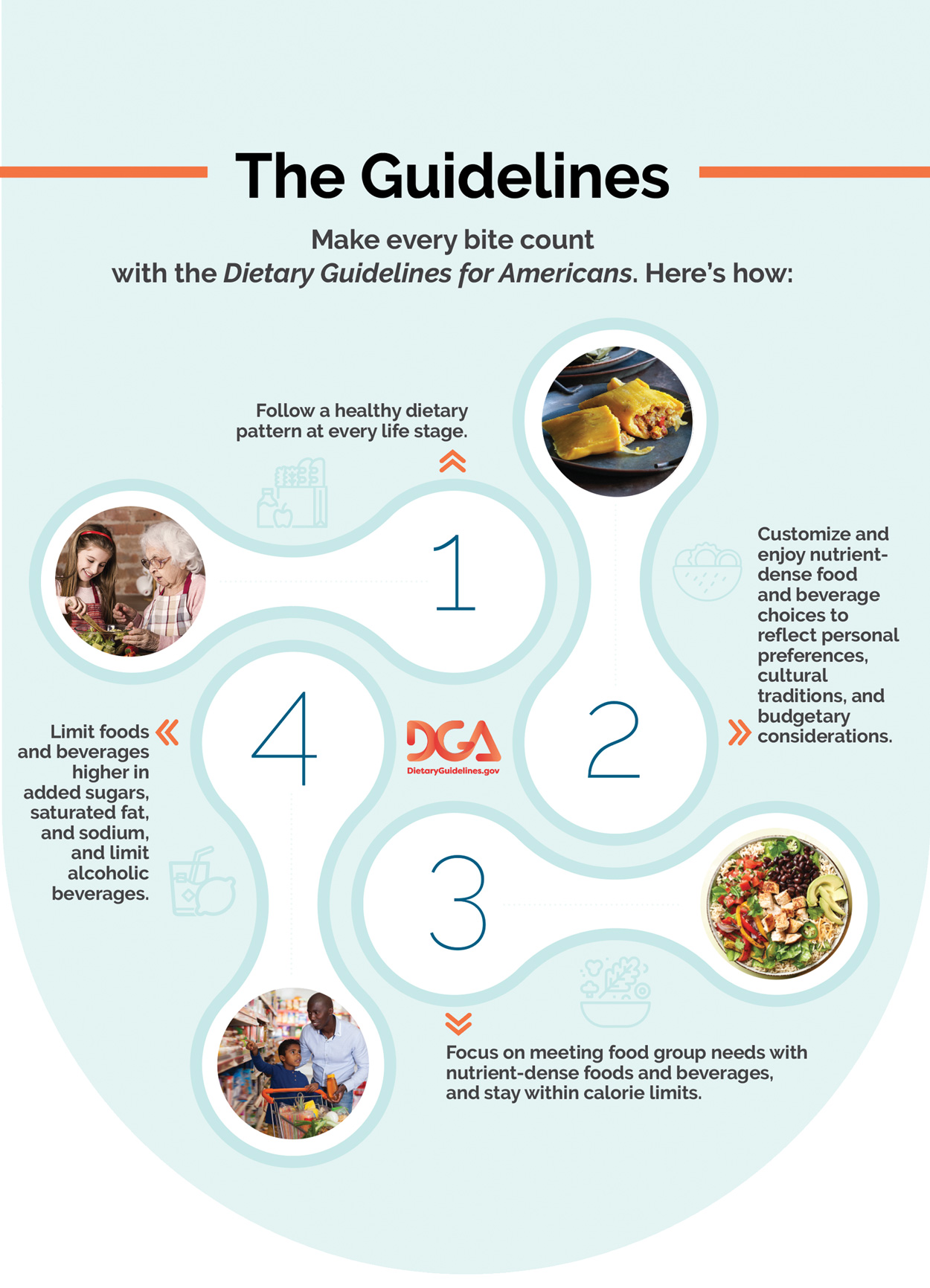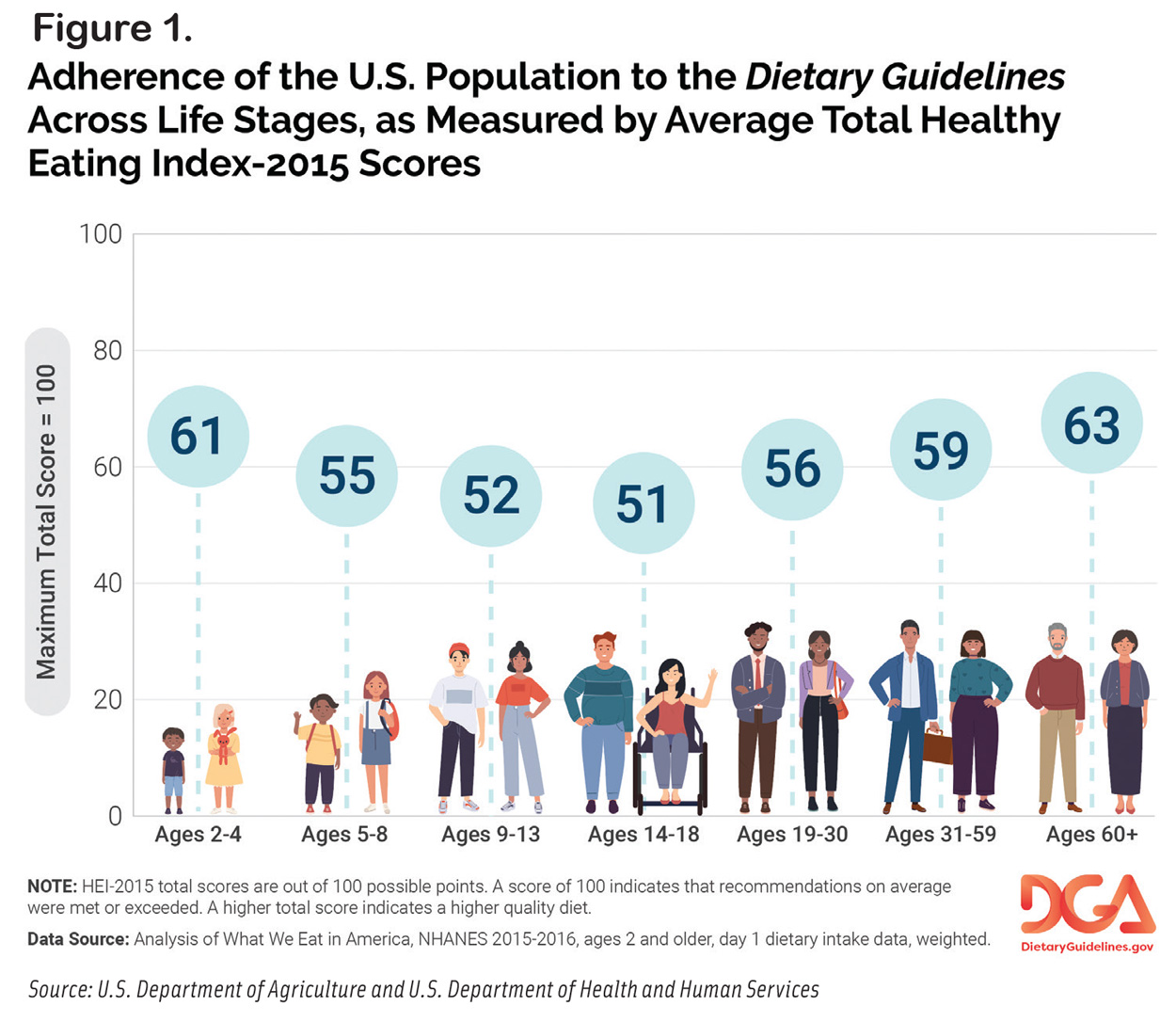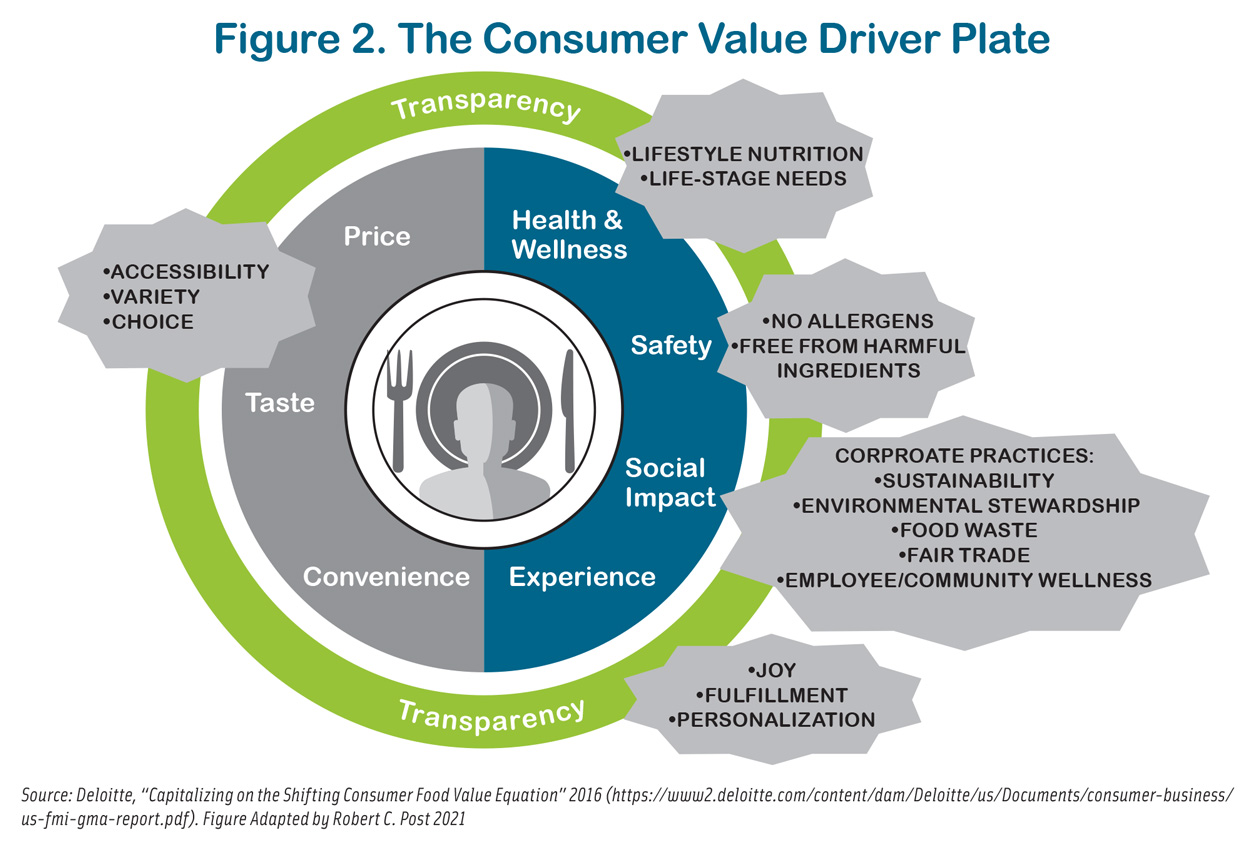
Do the New Dietary Guidelines for Americans Leave Key Questions Unanswered?
Although scientifically rigorous, the process underpinning the Guidelines misses some factors that influence consumers’ dietary decisions.
Article Content
Based on a robust analysis of the latest nutrition and health science, the 2020–2025 Dietary Guidelines for Americans published late last year promote better consumer dietary and lifestyle behaviors, serve as a unifying and authoritative source for health professionals to base advice and education, and provide a roadmap for food and beverage innovation. The process of developing the Dietary Guidelines involves convening an Advisory Committee made up of renowned researchers who independently examine the state of the scientific evidence on timely nutrition and public health topics and produce a Scientific Report of conclusions and recommendations on which the government’s policy, the Dietary Guidelines, is based.
Whether the Dietary Guidelines have a profound impact on all the targeted users—consumers, health professionals, and the food sector—depends on the topics and questions raised to inform them. The Dietary Guidelines advise Americans to “make every bite count,” but generally consumers have not heeded that advice. Are there topics and questions beyond those raised by the Advisory Committee that need to be addressed? Could answers to those questions help inspire Americans to do a better job of adhering to the Guidelines? What additional steps might policy makers take?
Themes and Recommendations
The 2020–2025 Dietary Guidelines recognizes that 60% of adults today have one or more diet-related chronic diseases. Therefore, the premise is that most Americans, no matter their health status, can benefit from shifting food and beverage choices to better align with healthy dietary patterns. The recommendations of the 2020–2025 Dietary Guidelines emphasize the importance of dietary patterns (the combinations of foods and beverages individuals consume over time) rather than individual nutrients, foods, or food groups. For the first time in 40 years, the Dietary Guidelines includes recommendations for healthy eating patterns for infants
and toddlers.
The 2020–2025 key recommendations are structured under four guidelines.
1) Follow a healthy dietary pattern at every life stage across the lifespan to meet nutrient needs, maintain a healthy weight, and reduce the risk of diet-related diseases. To help people apply the Guidelines at each life stage, there are evidence-based model dietary patterns—the Healthy U.S.-Style Dietary Pattern, Healthy Mediterranean-Style Pattern, and Healthy Vegetarian Dietary Pattern—each with amounts of food groups or subgroups needed to achieve optimal nutrient intakes and not exceed limits on components, such as added sugars.
2) Customize and enjoy nutrient-dense food and beverage choices to reflect personal preferences, cultural traditions, and budgetary considerations. It is reported that the science reviewed to inform the Dietary Guidelines and the principles for a healthy dietary pattern at all life stages represent the diversity of Americans.
3) Focus on meeting food group needs with nutrient-dense foods and beverages, within calorie limits. The model dietary patterns identify the nutrient-dense forms of foods and beverages in recommended amounts to promote health and reduce the risk of chronic diseases.
4) Limit foods and beverages higher in added sugars, saturated fats, and sodium, and limit alcoholic beverages. At every life stage, meeting these limits will increase the likelihood of achieving advised intakes of nutrient-dense choices from the recommended food groups.
Consumer and Marketplace Impacts
Because the Dietary Guidelines informs dietary guidance, nutrition education programs, and criteria used in federal policies and programs (including the national school meal programs), as well as the advice given by health and health-care professionals, the potential for impacting consumers is large. However, the impact may be a matter of how consumers perceive the importance of any recommendation and how feasible and relevant it is to follow. Similarly, the potential impact on the food sector depends on a number of factors, including the demands consumers make for foods that help them apply the Guidelines, and the feasibility of innovating or renovating production methods, formulations, and ingredients to make market-viable products that meet those demands. Adoption of the Dietary Guidelines by consumers is also a matter of how compelling nutrition influencers in each sector make the case for making better choices.
For example, recommendations on food components to limit, such as added sugars, in the past several Dietary Guidelines editions, have been amplified by health educators and professionals, and the media. Media coverage about the connection between sugar and obesity has a history implicating the Dietary Guidelines. The spotlight these influencers put on the Dietary Guidelines and recommended sugar limits is likely why the International Food Information Council’s (IFIC) 2020 Food and Health Survey showed 74% of consumers are trying to limit or avoid sugars and about 60% of those are attempting to do so by drinking water instead of caloric beverages, with just over 40% limiting certain foods and beverages in their diets.
Similarly, the “limit added sugars” recommendation has had an impact on the food sector with consumer attention focused on the risks (including obesity and diabetes) of diets high in sugars. The average daily added sugars intake for individuals one year and older is reported to be 266 calories per day, according to the new Dietary Guidelines, which is about the same as reported in the 2015 Dietary Guidelines (270 calories). The new Dietary Guidelines also reports the top sources of added sugars in diets of individuals one year and older are sugar-sweetened beverages (24%) and desserts and sweet snacks (19%), which are lower than the figures given for these food categories in the 2015 Dietary Guidelines—39% and 31%, respectively. This trend for meeting the demand for lower-sugar products tracks with market assessments. According to the Mintel Global New Products Database, launches of low-sugar and reduced-sugar/no-sugar foods increased by 19.2% from 2015 to 2017. More recently, Mintel reported that the low-sugar market, strictly defined as products that contain 3 g or less of sugar per serving, has scaled rapidly behind consumer demand across both foods and beverages.
The added sugars intake example notwithstanding, American consumers are generally not responding to the Dietary Guidelines recommendations. The new and previous Guidelines have stressed that, to be effective, no guideline or recommendation is to be taken in isolation of the others. To get the overall health benefits means applying the Guidelines in total: consuming healthy eating patterns that account for all the foods and beverages within an appropriate calorie level while choosing more nutrient-dense foods and limiting added sugars, sodium, and saturated fats. Yet the new Dietary Guidelines and previous iterations point out that eating patterns in the United States have remained far below the Guidelines recommendations, according to the Healthy Eating Index (HEI)-2015, a tool used by the federal government to measure overall diet quality (Krebs-Smith et al. 2018) (Figure 1). The HEI scores the adherence of the U.S. population to the Dietary Guidelines recommendations. Over time, Americans have underachieved the recommendations to consume more fruits and vegetables, lean protein foods, whole grains, and fat-free/low-fat dairy foods. Concurrently, Americans’ intakes of food components to limit, such as added sugars and sodium, have exceeded recommended limits. Thus, even with the efforts of nutrition influencers and food sector innovation, the Guidelines are not sufficiently compelling. So, why aren’t Americans following the Dietary Guidelines recommendations to a greater degree?
Unanswered Questions
The 2020–2025 Dietary Guidelines Advisory Committee identified topics and scientific questions deemed important and relevant to federal nutrition programs, policies, and consumer education priorities. The U.S. Department of Agriculture’s Nutrition Evidence Systematic Review team supported the Advisory Committee in conducting systematic reviews. The topics and questions raised by the 2020–2025 Advisory Committee were discussed openly at public meetings of the Committee throughout the Dietary Guidelines process and are posted at NESR.usda.gov. The Committee assessed the science to address topics and questions in the areas of dietary patterns, pregnancy and lactation, birth to 24 months, beverages and added sugars, dietary fats and seafood, and frequency of eating. Additionally, the Committee addressed topics and questions requiring data analysis (such as assessing typical food and nutrient intakes among population groups) and food pattern modeling (evaluating the impact of specific changes in amounts or types of foods and beverages in a dietary pattern on meeting food group recommendations and nutrient needs).
Thus, the important topics and questions raised to inform the current Dietary Guidelines are similar to those addressed historically about dietary patterns that reflect what and how much to eat to be healthy and reduce the risk of chronic diseases throughout the life span. These are absolutely critical to inform the best prescriptive recommendations to promote public health. Although Guideline 2 in this latest edition states that the Dietary Guidelines is a framework for individuals to customize and enjoy nutrient-dense food choices to reflect personal preferences, cultural traditions, and affordability, the science review stops short of instilling prevailing consumer behavior and the filters that people apply in making their food and beverage choices match the Guidelines. That may be because, to date, the science review, topics, and questions that inform the Guidelines have not addressed consumer behavior trends, which may be a flaw.
Consumers might finally embrace and adopt the recommendations if they are made relevant to them. This goes beyond biological, social, psychological, and economic determinants, to which Guideline 2 alludes (Cleveland Clinic 2020). It may be time for widening the scope of topics and questions to include prevailing consumer values, beliefs, perceptions, and priorities that drive Americans’ food choices. Understandably, some of the answers about why Americans make the food choices they do may not be science-based, and a lot of the information on behaviors is from surveys and marketing analyses that are not conducted using the same kind of research protocols as for measuring the relationships between food intakes and health outcomes. The information nevertheless can provide a needed dimension of knowledge to craft the Guidelines in a way that is relevant and motivating for more Americans.
What are some of the consumer values that guide Americans’ food and beverage choices? In 2016, Deloitte reported results of a nationwide survey of 5,000 consumers, which showed that, in addition to the traditional values of price, taste, and convenience, new drivers of health and wellness, safety, social impact, and experience were emerging—all within an overarching value of food manufacturers’ transparency and earned trust (Figure 2).
According to the IFIC 2020 Food and Health Survey, which included a weighted sample of 1,011 consumers between the ages of 18 and 80, the value drivers of purchase decisions have remained largely stable since 2010, with healthfulness, taste, price, convenience, and environmental sustainability being the top five. Further, more than 50% of consumers reported that they care more about the healthfulness of their choices than they did in 2010. “Healthfulness,” like Deloitte’s “health and wellness” food value, has been interpreted in several ways by consumers: About 40% of Americans followed a specific diet or eating pattern in the last year (up from 38% in 2019 and 36% in 2018), with intermittent fasting taking the lead as most common. “Clean eating” is second in the top diets based on value drivers the IFIC survey reported. Looking at the consumer value of “clean eating,” there are many meanings consumers perceive, e.g., “free from” certain ingredients (such as gluten-free and preservative-free), “nothing artificial,” “natural”, “humanely raised/grown,” “locally grown,” “whole foods–based,” “minimally processed,” “plant-based,” and “non-GMO,” among others. With the likelihood of people at different life stages avoiding or restricting foods from food groups based on these values, it is reasonable to believe that they impact how Americans interpret the Guidelines and choose to apply them, amend them in their own ways, or just ignore them. In fact, is has been reported in the literature that consumer food and nutrient choices are impacted by the beliefs of the clean food movement (Shelke 2020, Allen et al. 2018, and Ambwani et al. 2019).
Other questions not considered in setting the Guidelines, which may help improve their adoption by Americans, concern how the Dietary Guidelines recommendations relate to the plethora of diets Americans are known to follow. The science review on which the 2020 Dietary Guidelines is based focused on dietary patterns proven to reduce the risk of diet-related diseases. Clearly, as the HEI reports, Americans aren’t following the patterns the Dietary Guidelines advise. Thus, to what degree do the diets Americans follow impact their adherence to the Dietary Guidelines? U.S. News and World Report assesses diets and rates “the 39 best diets,” presumably because many Americans follow them. If the Dietary Guidelines process considered why these popular diets are more appealing, and the extent to which these popular diets align with or disagree with the recommendations, it might lead to Guidelines conveyed in a way that is more pertinent for Americans to follow.
Next Steps for Policy Makers
Each Dietary Guidelines recommendation should be assessed for its potential to be confusing or misperceived in the real world of consumer beliefs, values, and priorities. For example, in today’s food environment, advising a shift to dietary patterns with more plant-based foods has the potential to be misperceived as meaning people of all ages should avoid all animal-derived foods and beverages. A public-private Dietary Guidelines Implementation Advisory Committee could be formed with experts in consumer behavior and market trends to examine the Guidelines and reframe the recommendations from a consumer behavior perspective. The initiative could examine each Guideline and key recommendation in relation to real-time trends data and advise on ways to make them persuasive and more likely to be adopted by today’s consumers.
REFERENCES
Allen, M., K. M. Dickinson, and I. Prichard. 2018. “The Dirt On Clean Eating: A Cross Sectional Analysis of Dietary Intake, Restrained Eating and Opinions About Clean Eating Among Women.” Nutrients 10(9): 1266. doi: 10.3390/nu10091266.
Ambwani, S., M. Shippe, Z. Gao, et al. 2019. “Is #cleaneating a healthy or harmful dietary strategy? Perceptions of clean eating and associations with disordered eating among young adults. J. Eat. Disord. 7(1): 17.
Borra, S. and A. Bouchoux. 2009. “Effects of Science and the Media on Consumer Perceptions about Dietary Sugars.” J. of Nutr. 139(6): 1214S–1218S.
Cleveland Clinic. 2021. “The Psychology of Eating.” https://myclevelandclinic.org/health/articles/10681-the-psychology-of-eating.
Krebs-Smith, S. M., T. E. Pannucci, A. F. Subar, et al. 2018. “Update of the Healthy Eating Index: HEI-2018.” Acad. Nutr. Diet. 118(9): 1591–1602.
Shelke, K. 2020. “Clearing Up Clean Label Confusion.” Food Technol. 74(2): 40–51.











